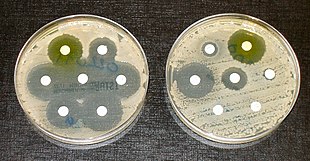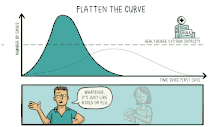Siouxsie Wiles
Siouxsie Wiles MNZM (born Susanna Wiles) is a British microbiologist and science communicator based in New Zealand. Her specialist areas are infectious diseases and bioluminescence.
Siouxsie Wiles MNZM | |
|---|---|
.jpg) Wiles after her investiture as MNZM in 2019 | |
| Born | Susanna Wiles United Kingdom |
| Alma mater | University of Edinburgh |
| Known for |
|
| Spouse(s) | Steven Galbraith |
| Children | 1 |
| Awards |
|
| Scientific career | |
| Fields | microbiology, science education |
| Institutions | University of Auckland |
| Influences | Robert T. Wilkins, Richard Preston |
| Website | Personal website |
She is the head of University of Auckland's Bioluminescent Superbugs Lab in which bioluminescence is used to advance the understanding of microbial infections such as food poisoning, tuberculosis and hospital superbugs.
Wiles is also an active science communicator appearing regularly in New Zealand's media and raising awareness of the high rates of infectious diseases in New Zealand as well as the problem of antibiotic resistance.
Early life
Wiles was born in the United Kingdom, grew up in the UK and South Africa and was raised by health conscious, left-wing parents. Her mother is a retired social worker and her father is a business owner. [1]
Education

Ebola was the microbe that started Wiles' interest in microbiology when she was a teenager. During her TEDxChristchurch talk in 2015 she said:
"This is the microbe that got me hooked on microbiology in the first place, because it’s both amazing and utterly terrifying. I was a teenager when I first read about Ebola and all I could think of was: How does this turn the human body into a virus producing factory?"[2]
The book The Hot Zone by Richard Preston, which focuses on Ebola, was what made Wiles focus her education on medical microbiology.[3]
Wiles studied at the University of Edinburgh and graduated in 1997 with a BSc(Hons) in Medical Microbiology. While an undergraduate, she received a Nuffield Scholarship and worked in the university's School of Biological Sciences.[3] Wiles completed her PhD at the Centre for Ecology and Hydrology in Oxford, previously known as the Institute of Virology and Environmental Microbiology.[4][5]
During her PhD Wiles first used bioluminescence to create biosensors to monitor the health of environmentally beneficial microbes.[6]
Professional life
After completing her PhD, Wiles moved to Imperial College London for a post-doctoral research position on tuberculosis. In 2007 she became a lecturer at Imperial College's Department of Infectious Diseases and Immunity,[7] and in 2009 was awarded a Sir Charles Hercus Fellowship from the Health Research Council of New Zealand and moved to the University of Auckland.[5] Wiles is the head of the university's Bioluminescent Superbugs Lab.[1][3]
In 2013 she won the Prime Minister's Prize for Science Media Communication which includes prize money of NZ$100,000.[1][4]
Wiles started the company Brightenz that sells kits with which one can create bioluminescent art at home.[8]
In 2018 Wiles became science ambassador for House of Science, a non-for-profit venture for raising science literacy in local communities.[9] She was also reelected as general Councillor of the Royal Society Te Apārangi in 2018.[10]
Wiles is also working on finding new antibiotics by screening 10,000 New Zealand fungi for possible medical use.[11]
Bioluminescent Superbugs Lab

Wiles leads the Bioluminescent Superbugs Lab at the University of Auckland which focuses on how glowing bacteria can advance the understanding of microbial infections such as food poisoning, tuberculosis and hospital superbugs.[4]
The bioluminescence is used to speed up the process of developing new antibiotics utilising the light emitted from the bacteria, because only living bacteria emit light.[6] About her work Wiles says "My career has been built on making nasty bacteria bioluminescent and using them for all sorts of things, including finding new medicines".[8] New Zealand has some of the highest rates of infectious diseases among developed countries. Globally 700,000 people die each year from drug-resistant diseases.[12]
Science communication
Wiles is passionate about demystifying science for the general public. She is an active blogger on Sciblogs.co.nz, an online podcaster, a commentator on Radio New Zealand and appears on TV shows to discuss science stories in the news.[3] She was one of the eight scientists who fronted the "Great New Zealand Science Project", the New Zealand government's public engagement programme leading to the National Science Challenges in 2012.[4][7][6]
She commissioned, co-wrote, and appeared with her daughter in the TVNZ online children's science show Siouxsie & Eve Investigate.[13]
From 2010 until 2016 Wiles was co-host of the Completely Unnecessary Skeptical Podcast which focused on skepticism in New Zealand.[14]
She has also used art and film to communicate scientific ideas: in 2011 she collaborated with Australian graphic artist Luke Harris to produce a series of animated films featuring bioluminescent creatures and their uses in science. The animations on NASA's use of fireflies for the search of extraterrestrial life was selected for inclusion in the 6th Imagine Science Film Festival in New York in 2013, and the Goethe Institute's 2014 Science Film Festival. Wiles collaborated with artist Rebecca Klee on an installation at the Auckland Art in the Dark Festival in 2013, which featured Hawaiian bobtail squid and Aliivibrio fischeri.[1][3][4] Wiles thinks that relevant science education should start in primary school, for increasing science literacy and interest in the field more generally.[9]

Her 2015 science communication projects include the Biolumination II exhibition.[15]
Wiles is active in the skeptical movement having received the Skeptic of the Year Award from the New Zealand Skeptics in 2016 and attended several NZ Skeptic Conferences. She has also spoken out against anti-vaxxers and other public health related issues.[16][17]
In 2018, Wiles was named as a finalist for New Zealander of the Year Awards for her work on antibiotic-resistant superbugs and infectious diseases.[18]
Wiles has been at the forefront of science communication in New Zealand during the COVID-19 pandemic.[19] With cartoonist Toby Morris Wiles created "Flatten the Curve", an animated GIF comic, for The Spinoff to describe how simple citizen actions could vastly reduce the death toll.[20] The comic went viral and was seen worldwide (including in Wikipedia). Called "the defining chart of the coronavirus", it was based on earlier graphics by the Centers for Disease Control and Prevention, Rosamund Pearce of The Economist, and Thomas Jefferson University professor Drew Harris.[21][22]
In 2020 Wiles was the subject of a documentary short entitled "Siouxsie and the Virus".[23]
Books and publications
Antibiotic Resistance
Wiles' book Antibiotic Resistance: The End of Modern Medicine? was published in 2017 and examined the growing global problem of antibiotic resistance.[7][24] Commenting on the book, University of Otago infectious diseases expert Professor Kurt Krause described it as "a clear call to action for New Zealanders on one of the most critical issues we face".[24] Sarah-Jane O'Connor from the Science Media Centre writes that the book "[…]Antibiotic Resistance will provide an excellent tutorial for those who know there’s cause for concern but need some extra background to understand why".[25]
Personal life
Wiles is married to Steven Galbraith, a professor of mathematics at the University of Auckland.[26] They have a daughter named Eve. She met her husband Steven, a New Zealander, in London and left her position at Imperial College London to move to New Zealand in 2009.[1][3]
She is a fan of Lego and likes to play with it while being a critic of what she describes as gender bias in the Lego minifigures.[27] She has dyed her hair since she was a teenager, and is known as the "pink haired science lady".[28]
Awards and recognition
- 3Rs Prize from the United Kingdom National Centre for the Replacement, Refinement and Reduction of Animals in Research (NC3Rs) in 2005[5][7]
- New Zealand National Animal Ethics Advisory Committee Three Rs Prize, 2011[5]
- New Zealand Association of Scientists' Science Communication Prize (now known as the Cranwell Medal), 2012[5]
- Prime Minister's Prize for Science Media Communication, 2013[1][5]
- Royal Society of New Zealand's Callaghan Medal, 2013[5][29]
- Blake Leader Award from the Sir Peter Blake Trust, 2016[30]
- New Zealand Skeptics' Skeptic of the Year Award, 2016[17]
- Appointed a Member of the New Zealand Order of Merit, for services to microbiology and science communication, in the 2019 New Year Honours.[5][7]
References
- Laxon, Andrew (23 November 2013). "Michele Hewitson interview: Siouxsie Wiles". New Zealand Herald. ISSN 1170-0777. Retrieved 12 February 2020.
- "How Glowing Bacteria Can Save The World | Siouxsie Wiles | TEDxChristchurch". YouTube. TEDx Talks. 8 May 2015. Retrieved 13 February 2020.
- "Siouxsie Wiles | The University of Edinburgh". www.ed.ac.uk. Retrieved 13 February 2020.
- "The Prime Minister's Science Media Communication Prize 2013". www.pmscienceprizes.org.nz. Retrieved 13 February 2020.
- "Associate Professor Siouxsie Wiles". unidirectory.auckland.ac.nz. Retrieved 13 February 2020.
- "Siouxsie Wiles". Royal Society of New Zealand. Retrieved 13 February 2020.
- "New Year honours list 2019". Department of the Prime Minister and Cabinet. 31 December 2018. Retrieved 13 February 2020.
- "Putting the Spotlight on Artists Who Glow". Signal to Noise Magazine. 6 September 2018. Retrieved 13 February 2020.
- "Associate Professor Siouxsie Wiles announced as House of Science ambassador". Royal Society of New Zealand. Retrieved 12 February 2020.
- "2018 Council Election - Results". Royal Society of New Zealand. Retrieved 12 February 2020.
- "Siouxsie Wiles on the end of antibiotics". RNZ. Retrieved 13 February 2020.
- Morton, Jamie (15 December 2019). "Could superbug 'Kryptonite' be in NZ forests?". New Zealand Herald. Retrieved 14 February 2020.
- "Siouxsie & Eve Investigate". Retrieved 16 February 2020.
- "About The CUSP". Web Archive. The CUSP. 15 December 2019. Archived from the original on 20 October 2016. Retrieved 13 February 2020.
- "thinkScience at the Auckland Arts Festival – Biolumination II". Sciblogs. 23 March 2015. Retrieved 16 February 2020.
- Gerbic, Susan (10 February 2020). "NZ Skeptic Conference – Christchurch – 2019". Skeptical Inquirer. CSICOP. Retrieved 13 February 2020.
- "Denis Dutton Award for New Zealand Skeptic of the Year". NZ Skeptics. Retrieved 10 December 2016.
- "New Zealander of the Year Finalists Announced". nzawards.org.nz. Retrieved 13 February 2020.
- Macdonald, Nikki (21 March 2020). "Scientist Siouxsie Wiles has dropped everything to tell Kiwis about coronavirus". Stuff. Retrieved 28 March 2020.
- Toby Manhire (14 March 2020). "Covid-19: All arrivals to NZ must self-isolate for 14 days. Here's what you need to know". The Spinoff.
(NZ Prime Minister) Jacinda Ardern with a print-out of the Spinoff 'Flatten the Curve' visual by Siouxsie Wiles and Toby Morris. (Photo by Dave Rowland/Getty Images)
- Chow, Denise; Abbruzzese, Jason (12 March 2020). "What is 'flatten the curve'? The chart that shows how critical it is for everyone to fight coronavirus spread". NBC News.
- Wilson, Mark (13 March 2020). "The story behind 'flatten the curve,' the defining chart of the coronavirus". Fast Company. Retrieved 3 April 2020.
- "Covid-19 scientist Siouxsie Wiles reveals appalling social media abuse". NZ Herald. 3 July 2020. ISSN 1170-0777. Retrieved 6 July 2020.
- "Antibiotic Resistance – The End of Modern Medicine?". BWB Bridget Williams Books. Retrieved 13 February 2020.
- "Book review: Antibiotic Resistance – the end of modern medicine?". SciBlogs. Retrieved 13 February 2020.
- "Steven Galbraith". University of Auckland. Retrieved 4 April 2020.
- "Building blocks of bias: Lego and gender | Siouxsie Wiles | TEDxAuckland". YouTube. TEDx Talks. 19 May 2015. Retrieved 13 February 2020.
- Associate Professor Siouxsie Wiles at Auckland University
- "2018 New Zealander of the Year finalist - Dr Siouxsie Wiles". Royal Society of New Zealand. Retrieved 12 February 2020.
- "Sir Peter Blake Trust honours leaders at black-tie awards". Retrieved 13 February 2020.
External links
| Wikimedia Commons has media related to Siouxsie Wiles. |